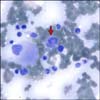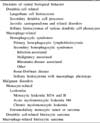Abstract
Macrophage activation syndrome (MAS) is a severe, potentially life-threatening complication of childhood systemic inflammatory disorder, primarily systemic onset juvenile rheumatoid arthritis (SoJRA). It is characterized by pancytopenia, liver insufficiency, coagulopathy, and neurologic symptoms. The clinical manifestations are caused by the activation and uncontrolled proliferation of T lymphocytes and macrophages, leading to cytokine overproduction including tumor necrosis factor-α (TNF-α). Methylprednisolone pulse therapy and cyclosporine A have made a considerable progress in the treatment of MAS. However, the mortality rate remains high suggesting the need of another therapeutic agent. Several cases of MAS successfully treated with TNF-α inhibitor (etanercept) have been reported. We report the first Korean case of MAS successfully treated with combination therapy of corticosteroid, cyclosporine A and etanercept.
Figures and Tables
Figure 2
Bone marrow aspirate smears of a macropharge activation syndrome (MAS) demonstrating hemophagocytosis (arrow) (Wright stain, ×1,000).

References
1. Hadchouel M, Prieur AM, Griscelli C. Acute hemorrhagic, hepatic, and neurologic manifestations in juvenile rheumatoid arthritis: possible relationship to drugs or infection. J Pediatr. 1985. 106:561–566.
2. Athreya BH. Is macrophage activation syndrome a new entity? Clin Exp Rheumatol. 2002. 20:121–123.
3. Kelly A, Ramanan AV. Recognition and management of macrophage activation syndrome in juvenile arthritis. Curr Opin Rheumatol. 2007. 19:477–481.
4. Stéphan JL, Zeller J, Hubert P, Herbelin C, Dayer JM, Prieur AM. Macrophage activation syndrome and rheumatic disease in childhood: a report of four new cases. Clin Exp Rheumatol. 1993. 11:451–456.
5. Favara BE, Feller AC, Pauli M, Jaffe ES, Weiss LM, Arico M, et al. Contemporary classification of histiocytic disorders. The WHO Committee On Histiocytic/Reticulum Cell Proliferations. Reclassification Working Group of the Histiocyte Society. Med Pediatr Oncol. 1997. 29:157–166.
6. Lin YW, Horiuchi H, Ueda I, Nambu M. Recurrent hemophagocytic lymphohistiocytosis accompanied by Kikuchi's disease. Leuk Lymphoma. 2007. 48:2447–2451.
7. Muise A, Tallett SE, Silverman ED. Are children with Kawasaki disease and prolonged fever at risk for macrophage activation syndrome? Pediatrics. 2003. 112:e495.
8. Sawhney S, Woo P, Murray KJ. Macrophage activation syndrome: a potentially fatal complication of rheumatic disorders. Arch Dis Child. 2001. 85:421–426.
9. Prahalad S, Bove KE, Dickens D, Lovell DJ, Grom AA. Etanercept in the treatment of macrophage activation syndrome. J Rheumatol. 2001. 28:2120–2124.
10. Stéphan JL, Koné-Paut I, Galambrun C, Mouy R, Bader-Meunier B, Prieur AM. Reactive haemophagocytic syndrome in children with inflammatory disorders A retrospective study of 24 patients. Rheumatology (Oxford). 2001. 40:1285–1292.
11. Henter JI, Elinder G, Söder O, Hansson M, Andersson B, Andersson U. Hypercytokinemia in familial hemophagocytic lymphohistiocytosis. Blood. 1991. 78:2918–2922.
12. Stepp SE, Dufourcq-Lagelouse R, Le Deist F, Bhawan S, Certain S, Mathew PA, et al. Perforin gene defects in familial hemophagocytic lymphohistiocytosis. Science. 1999. 286:1957–1959.
13. Filipovich AH. Hemophagocytic lymphohistiocytosis and related disorders. Curr Opin Allergy Clin Immunol. 2006. 6:410–415.
14. Makay B, Yilmaz S, Türkyilmaz Z, Unal N, Oren H, Unsal E. Etanercept for therapy-resistant macrophage activation syndrome. Pediatr Blood Cancer. 2008. 50:419–421.




 PDF
PDF ePub
ePub Citation
Citation Print
Print





 XML Download
XML Download